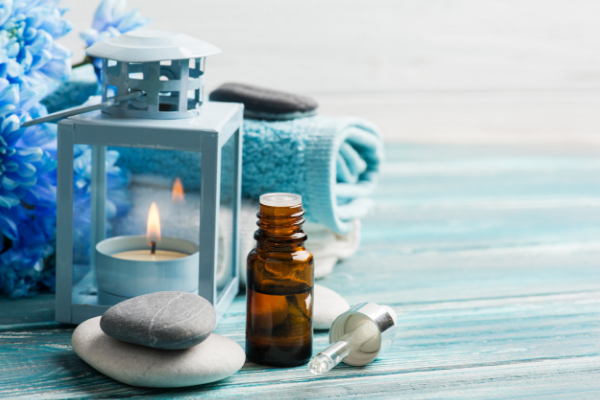
As a yoga teacher who specializes in teaching moms at all phases of life, I’m always looking for ways to help my students tap into their body’s relaxation response quickly. In yoga class, we use the yoga asanas to melt tension in the muscles. We use the breath to cue the nervous system to relax. And we use meditation, mindfulness, and affirmations to help calm the mind, too. Lately, I’ve been playing with incorporating the senses into the mix, too.
I’ve been playing soft, soothing music during Savasana. I put flickering LED candles around the room to appeal to the eyes. I’ve also been playing with different ways to appeal to the sense of smell to help boost the benefits of the practice.
After all if body, mind, and spirit are intricately connected, all of the senses are connected, too. And they can all work together to give you a more complete experience of the practice and foster relaxation, focus, more energy, or any other feeling you’re going for from your yoga practice.
(Just think of the difference between practicing with soft, instrumental music versus practicing to a rock ballad. Very different experiences!)
But if you’re new to the essential oils it can seem overwhelming. There are SO many different types of oils that are supposed to do so many different things! There are also lots of different ways to use them. If you’ve been interested in oils, but are not sure where to start, you’ve come to the right place.
When to Use Essential Oils During Yoga
It’s yoga etiquette 101 that you shouldn’t go into a public, group yoga class wearing strong perfumes, scented skincare or beauty products, or essential oils. Like yoga, scent is a very personal thing. What you like might really bother someone else.
Also since scent can be so powerfully connected to emotions, something that relaxes you could trigger someone else. Please use oils to enhance your home yoga practice.
If you’re a yoga teacher, if you’re going to use oils in your yoga classes, please advertise that on your website and class schedule.
Kinds of of Essential Oils for Yoga
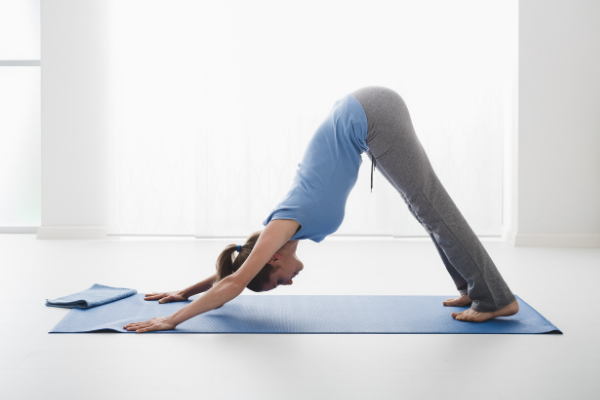
Choose a scent that will enhance of yoga practice you’ll be doing. If you’re like me and you are overwhelmed by the choices, I recommend keeping it simple. Whatever you do, just make sure you’re getting your oils from a high quality source. There are a lot of cheap brands out there that aren’t really what they seem. Young Living or DoTerra are only brands I’d use because I feel like I can trust the sources and I will be getting what’s on the label. It’s better to have two or three good quality oils than a whole kit of different, cheaper oils that won’t be effective.
The oil blends I mention here are from Young Living because that’s what I use in my own personal practice. (And, yes, if you want more information about how to get started with all of Young Living’s amazing healthy-boosting products, shoot me a message. I’m happy to send you some samples, help you get your starter kit, and set you up to get a nice, little discount of your own.)
Here’s a very quick, simple list of ideas for oils that you might use for different types of yoga.
For an active, energizing practice:
Try a citrus oil like Orange, Lemon, or Lime. Or something in the mint family like Peppermint or Spearmint.
For a calming, gentle practice like Restorative or Yin Yoga:
Lavender, Chamomile, or Ylang ylang
For a practice to help you focus or balance:
Try a grounding oil like Vetiver, Rosemary, or Peppermint
For a meditation or mindfulness-based asana practice:
Frankincense, Lavender, or Cedar wood are good choices
For an intuitive practice:
If you still feel overwhelmed by the above recommendations, just use a scent you like and forget it! I believe that a big part of the yoga practice should be learning to trust your instincts–your intuition. I often follow that intuition when I get on my mat and just do what feels good in the moment without much planning anyway.
So it’s also OK to just go with an oil with a scent you enjoy and trust that it will be a good fit for you that day. A scent you’re naturally drawn to will make you happier, calmer, and feel good (no matter what the oil guide books or blog posts say!). Truthfully, it’s hard to go wrong.
Experiment with mixing it up.
Once you have a gist for how different scents make you feel, you can start experimenting with mixing two or more oils to create your personal yoga blend.
Here’s mine – Valor, Lavender, and Frankincense. (I call it my Spoiled Mama Mist!)
Ways to Use Essential Oils During Yoga
Use a Diffuser.
A diffuser is just a tool that helps to put the oil out into the air so you can breathe it in. This is my favorite way to use oils because you can just turn it on and enjoy. Plus, if you get a fancy pants essential oil diffuser like I have, it’s a feast for your nose AND your eyes. Mine changes colors or flickers like a candle light. It’s kind of amazing.
Or email me at SpoiledYogi (at) Gmail (dot) com now for more info about how it works!
Use a roller ball to put it on your neck and wrists.
No diffuser? No problem. Get a roller ball bottle and add your favorite oil and a carrier oil so you don’t have to worry about diluting. A quick swipe or two and you’ll enjoy the oil scent every time you move from one pose to the next .
Try these* magical rainbow roller ball bottles. (*Affiliate link.)
Wear oil diffusing jewelry (or place some next to your mat as you practice).
I don’t have any of this jewelry yet, but I think it’s a neat way to use oils. If you don’t like to wear jewelry while you practice (I don’t), just put it next to your mat and enjoy.
How to Boost Your Relaxation Response with Essential Oils
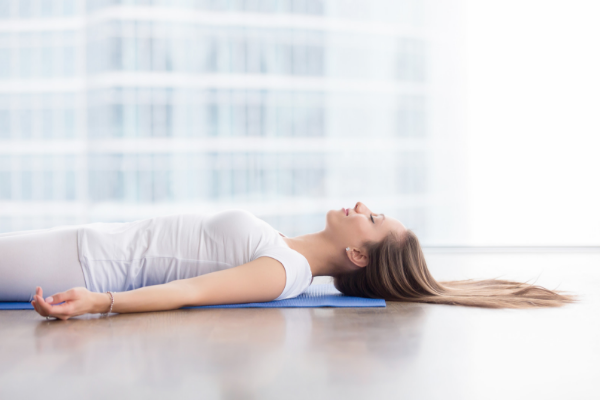
For me, Savasana (Guided Resting Pose) is when the magic happens. And I absolutely love anything that helps me enhance that dreamy, weightless, feeling of being completely relaxed. Soft music, a nice assist from a teacher, and essential oils are a great way to do just that.
Here are few of my favorite ways to use oils to help me relax more deeply in Savasana (or before bed!).
Set your diffuser on high, turn off the lights, and breathe in deeply as you rest.
Massage your feet, neck, and shoulders with a carrier oil + essential oil before you rest in Savasana. By the way when someone says “carrier oil” they just mean mix it with a different kind of oil like coconut oil, jojoba, or olive oil so the essential oil won’t be so strong.
Place a drop or two on a cool damp washcloth and use that over your eyes. You could also add add a drop to an eye pillow. (Steer clear of peppermint or any oils that feel tingly or “hot” on your skin. They aren’t good choices for the eyes!)
Bonus Tip: Use the same oil or combination of oils every time.
Since our minds are so linked to our senses, if you choose one oil that you always use during relaxation your mind and body will start to associate that scent with relaxation. That means that you can carry it with you and take a sniff during stressful times as a cue for your body and your nervous system to relax.
Using Essential Oils After Yoga
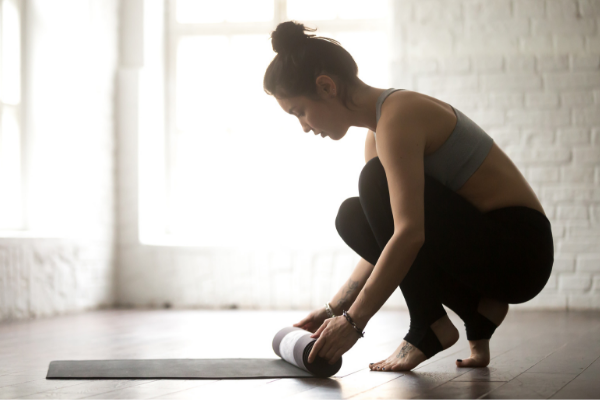
Don’t forget to wipe down your mat when you’re done!
Add a drop of Thieves or Purification to a spray bottle with water and a bit of Witch Hazel (as an emulsifier) and lightly mist your mat before you roll it up to keep germs at bay and to keep it smelling fresh and clean.
Are you sore from your yoga practice?
Try Panaway with a carrier oil to soothe overworked muscles as an alternative to ibuprofen or Tylenol. Or run a nice, warm bath and add a couple drops of your favorite, relaxing oil to the water.

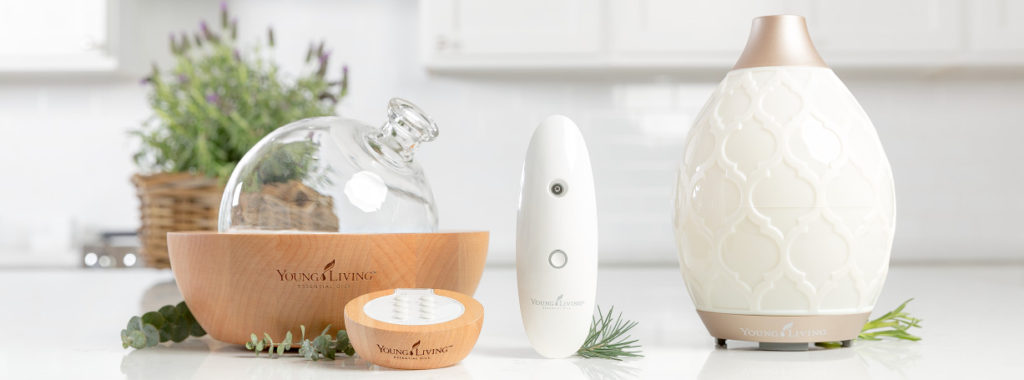

Comments